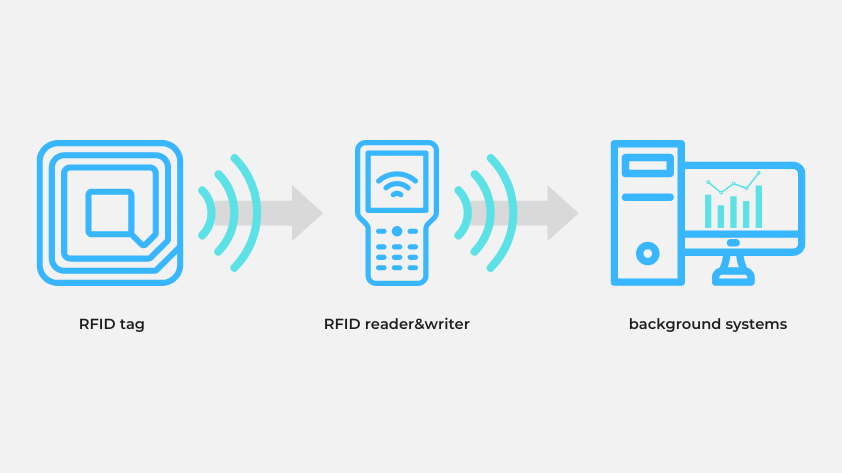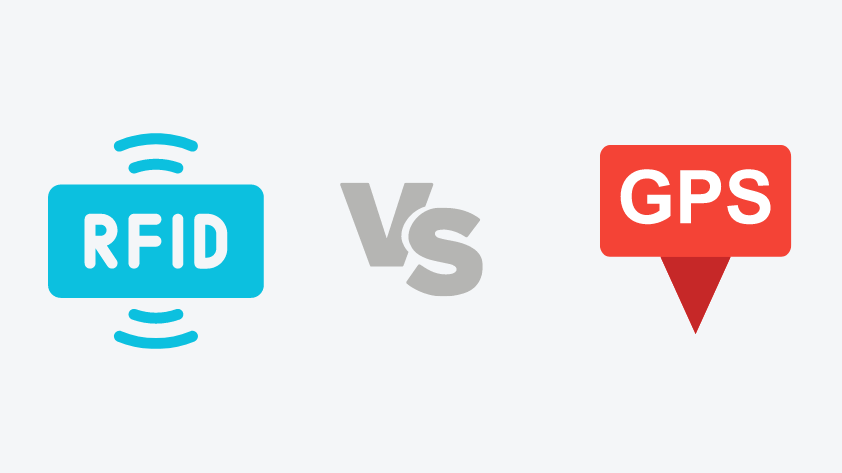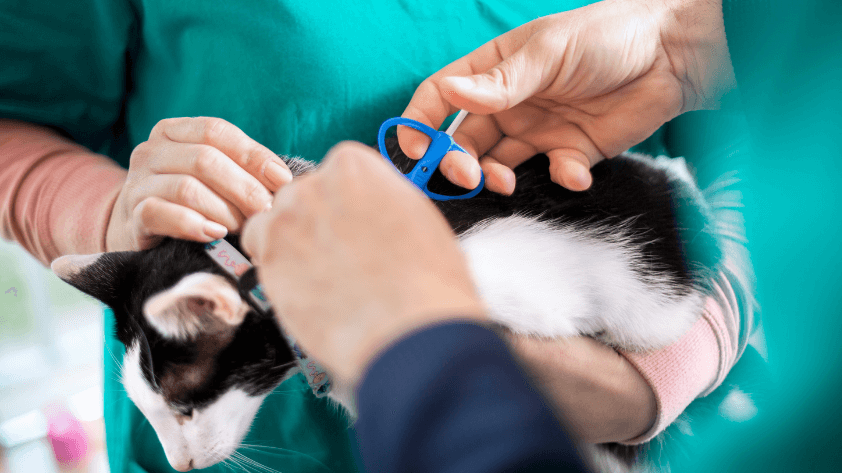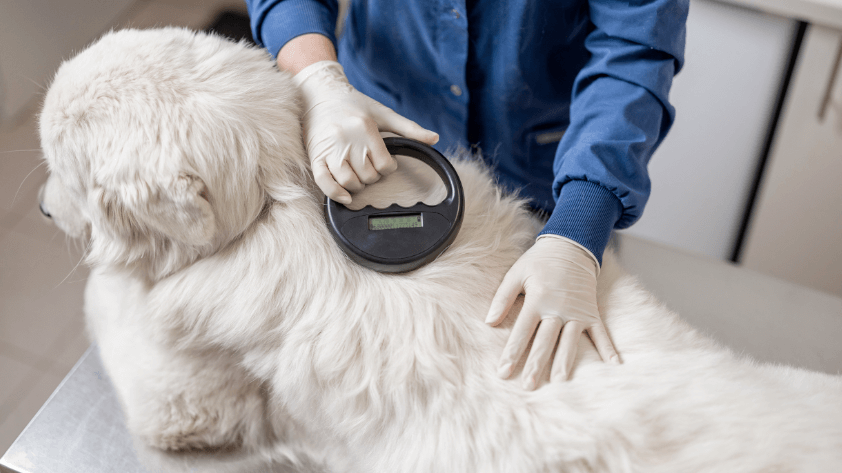
As the role of pets within contemporary families expands, the efficient oversight of their identification,
well-being, and routines has gained prominence among pet guardians and associated entities. The advent of
Radio Frequency Identification (RFID) technology presents a secure, dependable, and user-friendly solution
for pet administration. This technology not only aids pet owners in monitoring their pets’ locations in
real-time but also assumes an increasingly critical function in veterinary practices, animal sanctuaries,
and animal care establishments.
1. Understanding RFID Technology
RFID is an automated identification method that employs radio waves. It discerns and monitors items by means
of communication between RFID transponders, readers, and central management systems. A notable benefit of
RFID technology is the capacity to read its tags without requiring direct contact with the scanning device,
thereby enhancing operational versatility. In the context of pet management, each RFID tag can be linked to
specific details about the animal. This facilitates swift access to a pet’s identity, health history,
previous medical treatments, and other pertinent information through a simple scan of the RFID tag. This
provides considerable ease in both routine care and urgent situations. RFID technology is particularly
advantageous in locating lost pets and overseeing their health.

The Mechanics of RFID in Pet Management
To fully appreciate the practical use of RFID technology in pet management, it is essential to understand its
operational mechanics. The following outlines the interaction between RFID tags, readers, and the central
management system:
Tag Implementation: An RFID tag is affixed to the pet, typically via a collar, ear tag, or a
microchip that is surgically implanted beneath the skin by a veterinarian.
Data Acquisition: When the pet comes within range of an RFID reader at a specified location,
the reader uses radio waves to activate the tag and retrieve the data stored on it.
Data Processing: The reader then transmits the scanned data to the central management system,
which automatically confirms the pet’s identity and cross-references it with historical health records or
other essential data.
Data Presentation: Authorized users, such as pet owners or veterinarians, can access the pet’s
detailed information via a computer or mobile device.
Through these coordinated steps, RFID technology ensures prompt access to a pet’s identity and health
information, thereby significantly enhancing pet management efficiency. For those seeking a more in-depth
understanding of RFID technology, “What’s RFID Technology: A Comprehensive Guide for Beginners” offers
valuable insights for those new to the field.
2. Significant Advantages of RFID in Pet Management
RFID technology provides numerous benefits in pet management, establishing it as a highly desirable solution.
The following sections will examine its advantages in terms of safety, convenience, cost-effectiveness, health
monitoring, and regulatory compliance.

Safety and Reliability
RFID tags offer exceptional security and reliability. Once an RFID tag is implanted or attached to a pet, the
unique identifier it contains is unlikely to be altered or easily compromised. Compared to conventional
methods of pet identification, RFID tags are more resilient and less susceptible to loss or damage.
Convenience
RFID technology simplifies the process of retrieving pet information. A quick scan with a reader provides
immediate access to the pet’s identity and health details. This is especially useful during emergencies. For
example, if a pet becomes ill at home, a veterinarian can quickly scan the RFID tag to review its complete
medical history and administer appropriate treatment without delay.
Cost-Effectiveness
Although the initial setup costs may be slightly higher than those of traditional tagging systems, the
long-term cost benefits of RFID technology are clear. Passive RFID tags can last for many years and require
minimal upkeep. Compared to GPS devices, RFID is more economical and does not require frequent battery
replacements, making it suitable for continuous pet identity tracking. An implanted RFID chip can function
for the pet’s entire life without needing replacement, saving both time and money for pet owners and
veterinary facilities.
Health Monitoring
RFID tags can be used not only for identification but also for storing and managing pet health information. By
linking the tag to the pet’s medical records, veterinarians can monitor the pet’s health status in real-time.
This allows them to send health alerts to pet owners, such as reminders for vaccinations or check-ups on
previous medical conditions, ensuring continuous monitoring of the pet’s health.
Compliance
Many regions have implemented stricter regulations regarding pet management, requiring clear identification to
prevent loss or abandonment. RFID technology effectively addresses these requirements. By providing each pet
with a unique RFID tag, pet owners and management agencies can more easily comply with legal standards and
reduce the incidence of pet abandonment. In some European countries, laws require pets to be implanted with
RFID chips as part of their identification process, which helps manage stray animals and promotes animal
welfare.
3. Beneficiaries of RFID Pet Management Solutions
RFID technology is a valuable tool not only for pet owners but also for veterinary hospitals, animal shelters,
and pet care facilities.

3.1 Pet Owners
Benefits: Pet owners are primarily concerned with the safety and health of their pets. RFID
tags allow them to quickly identify their pets, especially if they are lost, significantly increasing the
chances of reuniting with them. Additionally, by linking the tags to the pet’s health records, owners can
easily access important information such as vaccination status and past medical history, which facilitates
daily care and communication with veterinarians.
RFID technology enables pet owners to manage their pets more efficiently and conveniently. Specific benefits
include:
Quickly Locating Lost Pets:
RFID tags provide pets with unique identification codes. If a pet is lost and found, a pet hospital or shelter
can scan its RFID tag to retrieve relevant information and quickly contact the owner, greatly improving the
chances of recovery. This method is particularly useful when a visible tag or collar is not present,
preventing misidentification of the pet.
Health Status Monitoring:
RFID tags can be linked to pets’ health records, allowing owners to track vaccination records, disease history,
and other vital information at any time. During routine health checks, veterinarians can quickly access
relevant data by scanning the RFID tags, simplifying the pet medical management process and ensuring accurate
health oversight.
Personalized Reminders for Disease Prevention:
RFID systems can provide personalized health reminders for pet owners, such as notifications for vaccination
appointments and routine check-ups. This feature helps owners stay vigilant about their pets’ health and
avoid issues arising from missed medical appointments.
Tracking Daily Activities:
Some advanced RFID technologies can also monitor pets’ daily activities, helping owners understand their pets’
behavioral patterns. Abnormal behaviors, such as a decrease in appetite or reduced activity levels, can serve
as early warning signs of potential health issues, enabling timely detection and intervention.
Pet Insurance and Regulatory Compliance:
In certain regions, pet management regulations mandate that pets have unique identification, and RFID chips
fulfill this requirement. This helps pet owners comply with legal standards and reduces the risk of fines or
losing their pets. Additionally, some pet insurance companies require RFID chips as a condition for applying
for pet insurance, thereby assisting owners in safeguarding their pets’ medical needs.
RFID technology provides pet owners with a comprehensive set of management tools, simplifying daily care and
enhancing the safety and health of their pets.
3.2 Pet Hospitals and Veterinary Clinics
Benefits: For pet hospitals, RFID technology can significantly enhance management efficiency.
By assigning each animal a unique RFID identity tag, veterinary clinics can manage a pet’s medical history,
medication records, and health status with greater accuracy, thereby reducing the likelihood of errors. The
rapid scanning and identification capabilities also save valuable time during diagnosis and treatment,
especially in emergencies.
RFID technology offers substantial management advantages to pet hospitals and veterinary clinics, helping them
improve efficiency and service quality in the following areas:
Quickly Identify Pets:
RFID tags provide each pet with a unique identity code. Veterinarians can instantly access detailed
information about the pet, including past medical history, vaccination status, and more, simply by scanning
the tag. This reduces the time spent manually checking medical records and boosts work efficiency,
particularly in emergencies, allowing for faster diagnosis and treatment.
Reduce Human Errors:
Traditional paper records are susceptible to data entry mistakes or loss. With RFID technology, medical
records and related information are directly linked to the tag, ensuring the accuracy and completeness of
data while avoiding the need for repeated checks or the risk of missed information.
Optimize Medical Record Management:
RFID tags not only assist in identifying pets but also help track their medical processes. Hospitals can obtain
and update pets’ health information and medication records by scanning RFID tags. This enhances the efficiency
of medical record management, reduces reliance on manual input, and facilitates long-term data analysis and
management.
Hospitalized Pet Management:
For pets receiving hospitalization, RFID technology aids hospitals in tracking hospitalization records, ward
locations, and treatment progress. Through the tags, hospitals can monitor the health status of each
hospitalized pet in real-time, ensuring the correct implementation of treatment plans and allowing for quick
information retrieval when necessary.
Better Inventory Management:
Some veterinary clinics also utilize RFID technology to manage their inventory of medications and medical
supplies. By attaching RFID tags to drug packaging, hospitals can monitor inventory levels in real-time,
ensuring that medications are neither expired nor in short supply, thereby improving the efficiency of
medical supply management.
RFID technology not only optimizes the daily operations of pet hospitals and clinics but also enhances the
quality of medical care, ensuring that pets receive timely and accurate treatment.
3.3 Animal Shelters
Benefits: Animal shelters often encounter challenges in identifying and managing the health of a
large number of animals. RFID technology offers these institutions an efficient and cost-effective solution.
By implanting or affixing RFID tags to each sheltered animal, shelters can quickly identify the animal’s
identity and check admission times, health statuses, and adoption progress, thereby significantly enhancing
management efficiency.
RFID technology can greatly improve the management efficiency of animal shelters, aiding them in better
managing pet identity, health status, and the adoption process. Specifically, RFID technology provides
advantages to animal shelters in the following areas:
Accurate Management of Pet Identity:
Each animal entering the shelter can receive a unique identity through an RFID tag. Shelter staff only need to
scan the RFID tag to immediately access the animal’s identity information, including admission time, health
status, and any potential adoption records. This systematic management reduces the error rate associated with
manual input while ensuring the integrity and traceability of each pet’s information throughout its stay at
the shelter.
Optimize Health Status Tracking:
RFID tags serve not only for identity identification but can also store pet health records. Shelters can track
each pet’s vaccination status, health examination results, and more in real-time through the RFID system.
When a pet requires medical care or vaccinations, the RFID system sends reminders to ensure that no necessary
care is overlooked.
Speed Up the Adoption Process:
RFID technology helps shelters streamline the adoption process. Staff can quickly access a pet’s health
information, adoption status, and history by scanning the pet’s tag. This allows potential adopters to
obtain basic information about the pet more efficiently, improving adoption rates and minimizing the risk of
information omissions.
Prevent Pets from Being Lost:
In certain situations, sheltered animals may move within the shelter or accidentally wander out of secure
areas. The RFID system can help shelters detect and prevent animals from going missing or entering unsafe
zones by tracking the pets’ activities in real-time, thereby enhancing safety management.
Improve Adoption Matching:
RFID systems can assist shelters in conducting large-scale data analysis to identify pets that best meet the
specific needs of adoptive families. By analyzing health, personality, and historical behavior data of the
pets, the system can recommend more suitable matches for adopters, thereby increasing the success rate and
satisfaction of adoptions.
In these ways, RFID technology not only enhances the management efficiency of animal shelters but also helps
protect pets, ensuring they receive timely care and more efficient adoption services.
3.4 Pet Care Institutions (Hosting and Fostering Centers)
Benefits: Pet care institutions can leverage RFID technology to monitor pet activities in
real-time, ensure pet safety, and provide personalized care services for each animal. The real-time tracking
capability also enables staff to respond swiftly in the event of any abnormal situations.
For pet care institutions, such as hosting centers and fostering centers, RFID technology enhances management
efficiency and pet safety in several ways:
Real-time Tracking of Pet Activities:
RFID tags allow pet care institutions to track pet activities and locations in real-time. This tracking
feature helps staff ensure that pets remain within safe areas. If a pet leaves a designated zone, the system
will trigger an alarm, enabling staff to respond quickly and prevent potential dangers.
Simplified Entry and Exit Records:
Each pet entering the care institution is equipped with an RFID tag, allowing the system to automatically log
the pet’s arrival and departure times. This not only streamlines daily management but also alleviates the
burden of manual record-keeping, ensuring data accuracy.
Personalized Care:
RFID tags can store information about pets’ special needs and historical data, such as eating habits, health
conditions, and behavioral traits. Caregivers can quickly access each pet’s requirements by scanning the tag,
enabling them to provide more personalized and accurate care services. For instance, some pets may require
specific diets or medical attention, and the RFID system ensures that staff do not overlook any critical
information.
Health Monitoring and Safety Assurance:
RFID tags can also assist care institutions in recording pets’ health statuses, including medication times,
medical histories, and other relevant information. Throughout the pet’s stay, the RFID system can remind
staff to perform routine health checks or administer necessary medications, ensuring comprehensive monitoring
of the pet’s well-being.
Improve Communication Efficiency:
When pet owners seek updates on their pets, the RFID system can quickly provide detailed care records, entry
and exit times, and activity logs. This enables care institutions to communicate more effectively with pet
owners, improving overall customer satisfaction.
Through these functionalities, RFID technology helps pet care institutions optimize management processes, enhance
the safety and comfort of pets, and ensure that all animals receive personalized and timely care services.
4. Challenges and Solutions in RFID Pet Management
While the adoption of RFID technology in pet management offers numerous advantages, it also presents certain
practical challenges, each with corresponding solutions. The following outlines common challenges and
potential solutions:

Cost Considerations
Challenge: The initial investment in RFID systems can be substantial for pet owners,
hospitals, and institutions, particularly concerning the costs of implanted chips, readers, and data
management systems. This may discourage smaller institutions and individual pet owners from adopting the
technology.
Solution: Despite the initial costs, RFID tags typically require minimal maintenance and can
last for a decade or more. To reduce the entry barrier, focus on addressing the most critical needs first or
offer a comprehensive solution that integrates RFID with other management tools, such as medical record
systems, to enhance the overall cost-effectiveness of the investment.
Public Acceptance and Awareness
Challenge: Although RFID technology is widely used in various industries, many pet owners
remain skeptical about implanted RFID chips, fearing potential health impacts on their pets or perceiving the
technology as complicated and difficult to use.
Solution: Enhance public understanding of RFID technology by providing clear explanations
regarding the safety, non-invasive nature, and long-term benefits of RFID chips through educational content.
Additionally, introducing simpler RFID application tools, such as portable scanners or smartphone-connected
readers, can further improve user experience.
Technology Dependence and Compatibility
Challenge: Different RFID systems may lack compatibility, preventing some hospitals or shelters
from reading RFID tags installed by other institutions, which hinders information sharing.
Solution: By adopting industry-standard RFID solutions, interoperability between different
devices can be ensured. Promoting unified standards for RFID devices will enable pet owners, shelters, and
hospitals to easily read and share data across various systems.
Limitations in Real-Time Outdoor Tracking
Challenge: While RFID excels in identity recognition and information management, it has limited
capabilities for real-time location tracking outdoors, particularly when monitoring large-scale pet
activities. This limitation distinguishes it from the real-time positioning capabilities of GPS or IoT
wearable devices.
Solution: Combining GPS Technology: Use RFID in conjunction with GPS
trackers, where RFID provides identity information and GPS handles real-time positioning outdoors. This
integrated approach can enhance the overall tracking capabilities for pet management.
5. Implementing RFID in Pet Management
Implementing an RFID system is a crucial step toward enhancing the efficiency of pet management. However,
different usage scenarios require specific equipment and steps to ensure that the system operates smoothly.
Here are some key steps and suggestions to help pet owners, pet hospitals, and care institutions effectively
apply this technology.

Step 1: Selecting Appropriate Equipment
Choosing the right equipment is a fundamental step in implementing RFID. Different types of RFID tags and
readers are suited for various application scenarios:
Passive RFID Tags:
These are low-cost tags designed for long-term identification of pet identity, often used in pet hospitals and
similar settings. Pet hospitals can associate medical records and other relevant information with pets through
passive tags, facilitating quick data retrieval during diagnosis and treatment.
Active RFID Tags:
Equipped with a built-in battery, active tags have a longer signal transmission range and are ideal for
environments that require real-time monitoring, such as pet care centers. Although they come at a higher
cost, active tags enable real-time tracking of pet activities, allowing managers to respond swiftly to any
situation.
RFID Readers:
Readers are the core components of RFID systems. Pet hospitals, shelters, and care centers can opt for
handheld readers that allow for quick scanning and reading of pets’ identity and health information.
Step 2: Integrating with a Central Management System
Integrating the RFID system with backend software is key to streamlining management processes. For instance, a
pet hospital should integrate RFID data with its existing pet health management system, enabling
veterinarians to easily access medical records. Similarly, pet care centers or shelters can track pets’ entry
and exit, health status, and other relevant information through the integrated system.
Step 3: Equipment Installation and Maintenance
During the implementation process, ensure that the RFID tag is correctly installed on the pet, whether through
implantation or as a collar, and regularly check the operational status of both the tag and the reader. For
active tags, timely battery replacement is also a crucial maintenance step to ensure continued functionality.
By following these steps, pet owners, hospitals, and care institutions can effectively implement RFID
technology to enhance their pet management practices.
6. Common RFID Pet Management Solutions
Currently, a variety of RFID solutions are available on the market to effectively manage pets:

RFID Fob:
These are portable devices that can be attached to the pet’s collar, providing a convenient tracking method for
pet owners.
Implantable RFID Chip:
This chip is implanted into the pet’s body through microsurgery, making it suitable for long-term
identification, especially in scenarios where the tag might be lost.
RFID Smart Feeder:
This device can automatically dispense food according to the needs of each pet by identifying the pet’s RFID
tag, ensuring a healthy diet. It is particularly useful in environments with multiple pets.
RFID Automatic Pet Door:
This is a pet door installed in the home that allows specific pets to enter and exit by recognizing the RFID
tag on their collar, preventing other animals from mistakenly entering.
Animal Ear Tag:
Though primarily used for farm animals, ear tags can serve as a reliable RFID solution in certain specialized
pet management scenarios.
Recommendations for Utilizing RFID Pet Management Solutions
Once the appropriate device is selected, installation and setup are crucial for successful implementation. Here
are some recommendations:
For pet owners, RFID tags can be affixed to the pet’s collar, or microchips can be implanted for a more
permanent solution.
Pet hospitals should ensure that the RFID reader is seamlessly integrated with the medical record management
system to facilitate real-time updates of pet information.
In animal shelters or pet fostering centers, the installation of RFID equipment should cover multiple locations,
including key areas such as entrances, exits, and activity zones. This ensures that the whereabouts of each
pet can be tracked at all times.
After the RFID system is installed, ongoing maintenance is essential. Pet managers should regularly check the
functionality of the tags, particularly for pets that frequently roam outdoors. Additionally, the data in the
backend system must be updated regularly to ensure that each pet’s health records and identity information
remain accurate.
By following these guidelines, pet owners and care institutions can maximize the benefits of RFID technology in
pet management.
7. Final Thoughts
The application of RFID technology in pet management offers significant advantages for pet owners, hospitals,
and care institutions. By enabling effective identification, real-time monitoring, and health management, RFID
not only enhances the safety and well-being of pets but also optimizes the operational efficiency of related
organizations.

Looking ahead, as technology continues to advance and costs decrease, the potential applications of RFID in pet
management will expand even further. We encourage pet owners, hospitals, and care institutions to actively
explore and adopt RFID systems to enhance the quality of life and safety for pets while achieving more
efficient management practices.
In summary, RFID technology presents an innovative and efficient solution for pet management, fostering
improvements in both pet welfare and management efficiency. We hope this guide serves as a valuable resource
for relevant personnel, helping them fully leverage the advantages of RFID technology in the realm of pet
management.
FAQs
1. What types of pets can benefit from RFID tracking?
RFID tracking is suitable for various pets, including dogs, cats, and even exotic animals like birds and
reptiles.
2. How does RFID compare to GPS for pet tracking?
While GPS offers location tracking over larger areas, RFID excels in short-range identification and tracking,
making it ideal for indoor or enclosed environments.
3. Can RFID help with lost pet recovery?
Yes, RFID tags can greatly assist in the recovery of lost pets by enabling shelters and veterinarians to
identify them and contact their owners quickly.
4. What are the costs associated with RFID pet management systems?
Costs can vary depending on the system and features but typically include initial setup fees, tag costs, and

RFID Antenna UHF
15-Meter Cable for UHF RFID Fixed Reader
UHF Tag
4″x2″ 860-960MHz UHF RFID Label RFID M4D
UHF Tag
4″x4″UHF RFID Label Alien H3 | ISO18000-6C
RFID Antenna UHF
5-Meter Cable for UHF RFID Fixed Reader
HF Card
ABS RFID KEY-FOB Tag RFID Classic 1K
HF Card
ABS RFID KEY-FOB Tag RFID Classic 4K
HF Card
ABS RFID KEY-FOB Tag RFID Ultralight C
HF Tag
ABS RFID KEY-FOB Tag RFID Ultralight EV1
LF Card
ABS RFID KEY-FOB Tag ATA5577
LF Card
ABS RFID KEY-FOB Tag EM4200
HF Card
ABS RFID KEY-FOB Tag EM4305
HF Card
ABS RFID KEY-FOB Tag RFID TAG 213